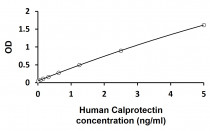ARG82070
Human Calprotectin ELISA Kit
Human Calprotectin ELISA Kit for ELISA and Human
Overview
| Product Description | ARG82070 Human Calprotectin ELISA Kit is an Enzyme Immunoassay kit for the quantification of Human Calprotectin in serum, plasma, milk, urine, saliva, CSF, cell lysate and cell culture supernatants. |
|---|---|
| Tested Reactivity | Hu |
| Species Does Not React With | Ms, Rat, Bov, Dog, Mk, Pig, Rb |
| Tested Application | ELISA |
| Specificity | Cross-Reactivity: Not react with Dog, Bovine, Monkey, Mouse, Rat, Pig and Rabbit Calprotectin. Not react with CD9, elastase, lactoferrin, lysozyme, myeloperoxidase, S100-A6, S100-A10, S100-A11, S100-A14, S100-A16 and S100-B. |
| Target Name | Calprotectin |
| Conjugation | HRP |
| Conjugation Note | Read at 450 nm. |
| Sensitivity | 0.042 ng/ml |
| Sample Type | Serum, plasma, milk, urine, saliva, CSF, cell lysate and cell culture supernatants. |
| Standard Range | 0.078 - 5 ng/ml |
| Sample Volume | 50 µl |
| Precision | Intra-Assay CV: 3.6%; Inter-Assay CV: 9.9% |
| Alternate Names | MA387; Leukocyte L1 complex light chain; 60B8AG; CFAG; p8; Urinary stone protein band A; P8; Calprotectin L1L subunit; NIF; S100 calcium-binding protein A8; MIF; MRP8; Calgranulin-A; Protein S100-A8; Migration inhibitory factor-related protein 8; CGLA; CAGA; L1Ag; Cystic fibrosis antigen; CP-10; MRP-8; S100A9; S100 calcium binding protein A9; MIF; NIF; P14; CAGB; CFAG; CGLB; L1AG; LIAG; MRP14; 60B8AG; MAC387; S100A8/A9 complex; S100A8/A9 heterodimer complex |
Application Instructions
| Assay Time | ~ 4.5 hours |
|---|
Properties
| Form | 96 well |
|---|---|
| Storage Instruction | Store components at 4°C or -20°C. Keep microplate wells sealed in a dry bag with desiccants. Do not expose test reagents to heat, sun or strong light during storage and usage. Please refer to the product user manual for detail temperatures of the components. |
| Note | For laboratory research only, not for drug, diagnostic or other use. |
Bioinformation
| Gene Symbol | S100A8; S100A9 |
|---|---|
| Gene Full Name | Calprotectin (S100A8/S100A9 complex) |
| Background | The protein encoded by this gene is a member of the S100 family of proteins containing 2 EF-hand calcium-binding motifs. S100 proteins are localized in the cytoplasm and/or nucleus of a wide range of cells, and involved in the regulation of a number of cellular processes such as cell cycle progression and differentiation. S100 genes include at least 13 members which are located as a cluster on chromosome 1q21. This protein may function in the inhibition of casein kinase and as a cytokine. Altered expression of this protein is associated with the disease cystic fibrosis. [provided by RefSeq, Jul 2008] |
| Function | S100A8 is a calcium- and zinc-binding protein which plays a prominent role in the regulation of inflammatory processes and immune response. It can induce neutrophil chemotaxis and adhesion. Predominantly found as calprotectin (S100A8/A9) which has a wide plethora of intra- and extracellular functions. The intracellular functions include: facilitating leukocyte arachidonic acid trafficking and metabolism, modulation of the tubulin-dependent cytoskeleton during migration of phagocytes and activation of the neutrophilic NADPH-oxidase. Activates NADPH-oxidase by facilitating the enzyme complex assembly at the cell membrane, transferring arachidonic acid, an essential cofactor, to the enzyme complex and S100A8 contributes to the enzyme assembly by directly binding to NCF2/P67PHOX. The extracellular functions involve proinfammatory, antimicrobial, oxidant-scavenging and apoptosis-inducing activities. Its proinflammatory activity includes recruitment of leukocytes, promotion of cytokine and chemokine production, and regulation of leukocyte adhesion and migration. Acts as an alarmin or a danger associated molecular pattern (DAMP) molecule and stimulates innate immune cells via binding to pattern recognition receptors such as Toll-like receptor 4 (TLR4) and receptor for advanced glycation endproducts (AGER). Binding to TLR4 and AGER activates the MAP-kinase and NF-kappa-B signaling pathways resulting in the amplification of the proinflammatory cascade. Has antimicrobial activity towards bacteria and fungi and exerts its antimicrobial activity probably via chelation of Zn(2+) which is essential for microbial growth. Can induce cell death via autophagy and apoptosis and this occurs through the cross-talk of mitochondria and lysosomes via reactive oxygen species (ROS) and the process involves BNIP3. Can regulate neutrophil number and apoptosis by an anti-apoptotic effect; regulates cell survival via ITGAM/ITGB and TLR4 and a signaling mechanism involving MEK-ERK. Its role as an oxidant scavenger has a protective role in preventing exaggerated tissue damage by scavenging oxidants. Can act as a potent amplifier of inflammation in autoimmunity as well as in cancer development and tumor spread. The iNOS-S100A8/A9 transnitrosylase complex directs selective inflammatory stimulus-dependent S-nitrosylation of GAPDH and probably multiple targets such as ANXA5, EZR, MSN and VIM by recognizing a [IL]-x-C-x-x-[DE] motif; S100A8 seems to contribute to S-nitrosylation site selectivity. [UniProt] |
| Cellular Localization | Secreted. Cytoplasm. Cytoplasm, cytoskeleton. Cell membrane; Peripheral membrane protein. Note=Predominantly localized in the cytoplasm. Upon elevation of the intracellular calcium level, translocated from the cytoplasm to the cytoskeleton and the cell membrane. Upon neutrophil activation or endothelial adhesion of monocytes, is secreted via a microtubule-mediated, alternative pathway. [UniProt] |
| Highlight | Related products: Calprotectin antibodies; Calprotectin ELISA Kits; New ELISA data calculation tool: Simplify the ELISA analysis by GainData |
Images (1) Click the Picture to Zoom In
Specific References
| Title | Download Link |
|---|---|
| ARG82070 Human Calprotectin ELISA Kit User manual |
 Download Download
|








